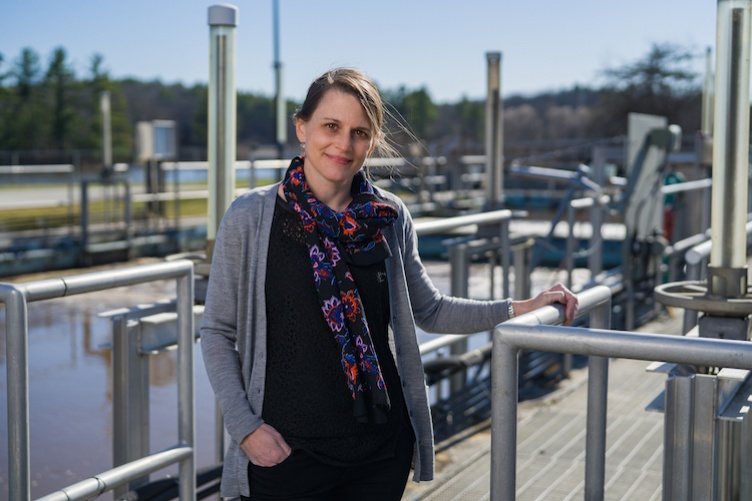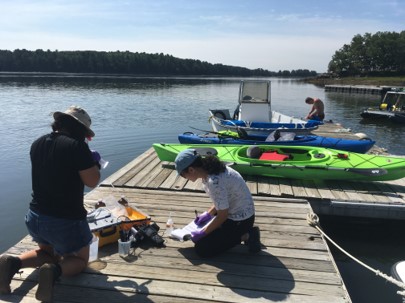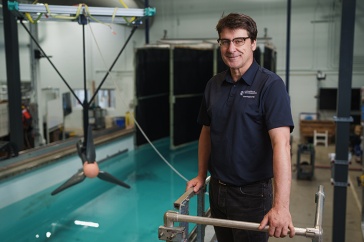
Paula Mouser, associate professor of civil and environmental engineering, at Durham's wastewater treatment facility.
UNH researchers have conducted two of the first studies in New England to collectively show that toxic man-made chemicals called PFAS (per-and polyfluoroalkyl substances), found in everything from rugs to product packaging, end up in the environment differently after being processed through wastewater treatment facilities—making it more challenging to set acceptable screening levels.

“PFAS are persistent substances that are not easily broken down and have been linked to adverse health effects,” says Paula Mouser, associate professor of civil and environmental engineering. “They are found in a wide variety of industrial, commercial and medicinal products and can end up in the body, human waste and the environment. If not managed correctly, they can be further distributed around the environment in landfills, waterways and even stabilized biosolids could be applied to agricultural fields as fertilizers.”
The researchers looked at the journey of 24 different PFAS through six New Hampshire wastewater treatment facilities, including those along the Great Bay Estuary near the N.H. Seacoast, to examine how they are distributed after being treated. PFAS come in two forms, long-chain and short-chain, which refers to the number of carbon atoms attached to fluorine in the compounds. In their first study, recently published in The Royal Society of Chemistry, the researchers found that short-chain PFAS ended up in the facility liquid, or effluent, while long-chain PFAS were more abundant in the sludge due to their higher affinity toward solids.
“State agencies across New England are all considering regulating PFAS in wastewater biosolids, but there is still more we need to know about how the treatment of wastewater sludge influences these forever chemicals.”
After going through a range of biological and disinfectant processes in the municipal wastewater treatment facilities, researchers found roughly 10% of the PFAS present in Great Bay could be traced back to the wastewater facilities. This suggests other dominant PFAS sources are contributing to the waterways like septic systems, agricultural land and urban runoff (which can contain biosolids), groundwater discharge from contaminated sites and surface water runoff.
Currently, the United States Environmental Protection Agency (EPA) has only issued a drinking water health advisory for two of the 4,700 known PFAS, so individual states are working to set their own standards for PFAS in drinking water, surface water and biosolids. In 2020, the New Hampshire Department of Environmental Services established maximum contaminant levels (MCLs) for four PFAS in drinking water, while in 2019, the Maine Department of Environmental Protection (DEP) established screening levels for three PFAS in biosolids.
In the UNH researchers’ second study, featured in the New England Water Environment Association Journal, the researchers used Maine’s screening levels to look at both PFAS and PPCPs, pharmaceutical and personal care products like antibiotics and flame retardants, in biosolids from wastewater treatment facilities in both New Hampshire and Vermont. Of the 39 biosolids reviewed in the sludge waste, 29 had PFAS levels that exceeded screening levels set by the Maine DEP.
“State agencies across New England are all considering regulating PFAS in wastewater biosolids, but there is still more we need to know about how the treatment of wastewater sludge influences these forever chemicals,” says Mouser.
The researchers say the challenge is finding a safe and acceptable level for waste residue that doesn’t force facilities to deposit these solids in landfills which would be enormously costly, fill up landfills faster than anticipated and possibly lead to the leaching of PFAS into landfill wastewater that may continue the cycle by returning the not easily broken-down chemicals right back to treatment facilities.
The researchers say the studies highlight the knowledge gaps around contaminants of emerging concern, like PFAS, in wastewater residuals and stress that more research is needed to look at the influence of the facility design and operation on their treatment before costly upgrades are implemented in wastewater treatment facilities.
This research was funded by New Hampshire Sea Grant and the UNH Collaborative Research Excellence (CoRE) Initiative. Additional authors are UNH graduate students Elham Tavasoli, Sydney Adams, Cassidy Yates, Carmela Antonellis; UNH adjunct research associate Jenna Luek; and UNH professor of civil and environmental engineering James Malley.
-
Written By:
Robbin Ray ’82 | UNH Marketing | robbin.ray@unh.edu | 603-862-4864

















































